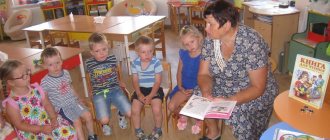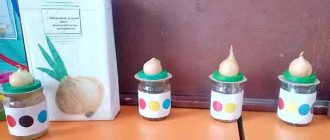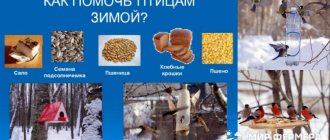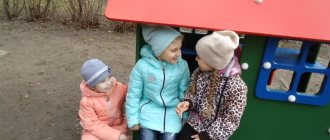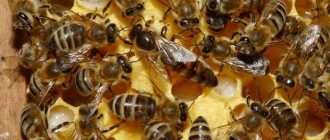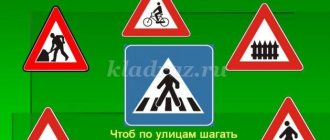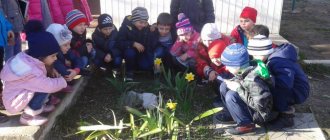Cyclic observations and methodological development on the topic
Cyclic observations.
In addition to the content, it is extremely important to determine the organizational and methodological form of conducting observations with children of those natural objects that are constantly located near them. Observations are best done in the form of cycles.
The inhabitants of this corner of nature live next to preschoolers throughout the school year - this circumstance leaves a special imprint on the pedagogical process: it is impossible for children to become indifferently accustomed to them over this long period. The pedagogical process should be structured in such a way that children’s interest in living beings constantly increases, so that they constantly expand their understanding of them, increase the volume of specific knowledge, so that by the end of the school year any child of senior preschool age could become a guide to a corner of nature - smartly and it’s interesting to talk about its inhabitants. These requirements are met primarily by such a form of pedagogical work as observation cycles, which are carried out not in the classroom, but at various routine moments in everyday life.
A cycle is a series of interconnected observations of a specific object in a corner of nature or a site in a kindergarten. Each of the observations in the cycle has its own content, its own purpose, does not repeat other observations, but is interconnected with them. In total, all observations of one cycle form in children specific and distinct ideas about a given object - its structure, functioning (various manifestations, behavior), living conditions. The cycle of observations allows the child to sensory and independently acquire a system of specific knowledge about the animals or plants that live in his neighborhood.
The cycle of observations as an organizational and methodological form of the pedagogical process has a number of advantages. In the cycle, the entire volume of knowledge is distributed into “portions”, which ensures their gradual and more reliable assimilation. Each subsequent observation allows children to demonstrate new aspects and features of an already familiar natural object, while simultaneously clarifying and expanding existing ideas.
The advantage of the cycle is its length in time - the distribution of observations, following one after another, for a sufficiently long period. Repeated (but with different content) reference to the same object for 1-3 months forms in children a stable cognitive interest in it. And as a result, preschoolers have a need for new observations, which they carry out independently (which is especially valuable), without the encouragement and guidance of the teacher. And, finally, conducting a series of observations in everyday life at different scheduled moments saves time for classes and makes work with children varied.
The cycle is carried out over a long period of time - one or two observations are planned per week. Thus, the presented cycle of 8 observations can be implemented in practice with children of older groups in 1.5-2 months. Such rather long-term communication between preschoolers and the inhabitants of the aquarium contributes to the development of their interest in this natural object.
A separate series of observations is compiled for each animal in a corner of nature in all age groups - children should know and love those pets who are their permanent neighbors. Special observation cycles are devoted to representatives of the plant world - indoor plants, spruce and birch (rowan, chestnut, apple, etc.) on the preschool site, primroses, as well as wintering birds, and frequently encountered insects. Everything that is constantly near the child must be noticed by him, must attract his attention, and arouse interest.
Hamster observation cycle
1. Hello, I'm a hamster!
Target. Induce an emotional positive attitude towards the hamster, a desire to watch him.
Progress of observation: Look. Who is this? Is the hamster big or small? Is this an adult animal or a baby? What color is a hamster? What is his body covered with? What kind of fur does he have? Pet him. Does a hamster look like a mouse? How is it similar? What is the difference? Let's call him Peak, like the mouse we read about from Vitaly Bianchi. Do you agree? What is the hamster doing? How is he behaving? Is he afraid of us? Where is he going? What helps him? Look and remember where the Peak is. Close your eyes, now open them. Where is he now? What is he doing? Is a hamster a calm animal or an active one? Is it easy to catch him?
Self-observation task. The hamster is a very interesting and funny animal. Watch him. If you see something interesting in his behavior, tell us all.
2. Let's make a good home for the hamster.
Target. Show that good conditions for a hamster, under which he will feel normal and not get sick, are a spacious cage (or aquarium), bedding made of sand or sawdust, a house or hole in which the hamster will build a nest, a ladder, a running wheel, a device for the toilet. Learn to provide assistance in equipment (apartment) for the animal.
Progress of observation: Let's see where Peak lives? What kind of house is it convenient for him to live in - spacious or cramped? What's at the bottom of the house? Is the sand clean? What needs to be done to keep it clean? Sveta, help me collect sand from the cage and sift it. Why do you need sand in a cage at all? Where did Peak make his nest? That's right, in the house. This house is like a mink. He likes to hide and sleep in it. He stores his supplies in it. What else is there in a hamster cage? Does he use stairs? What kind of jar is this? That's right, toilet. A hamster is a very clean animal, and we must help it and maintain cleanliness. Is it good for Piku to live in his house if all the conditions have been created so that he does not need anything? So that Peak doesn't get bored, let's put a wheel in the house and see what he will do with it?
3.Is the hamster okay in its new environment?
Target. Learn to notice how the hamster behaves in a new environment (the teacher moves the hamster to a new house in advance), what actions it performs, and evaluate them correctly. Determine the hamster’s well-being, teach him to draw conclusions by answering the questions: Is his home well organized? What is missing and what can be improved?
Progress of observation: Where does Peak live? What is a hamster cage? Does he have a good house? How can you determine this? (observe his behavior). Let's watch the hamster. What is he doing? What are you doing? (He walks around the walls, sniffs, moves his nose and antennae. He examines everything, climbs everywhere. He gets acquainted with the situation. He found out everything, he has nothing to fear. He is not afraid.) What do you see at the bottom of the cage? Why did we put sand there? What kind of jar is in a hamster cage? (Toilet). Can he be called clean? What is a house for him? (Mink). Why does a hamster need a mink? who else lives in the same place as Peak, that is, in a hole? (Mouse). What is Peak doing in the hole? What actions does it perform with the wheel? Isn't Peak afraid? Is he sick? How to determine this? When is it more common to see a hamster, during the day or in the evening? What is this connected with?
At the end of the observation, you can invite the children to draw Peak in his house.
4. What and how a hamster eats.
Target. Find out what and how a hamster eats? What food does he prefer? (Do not feed the hamster until observation).
Progress of observation: Guess the riddle:
- Gray animal, lives in a group,
He's friends with the guys
Carrots, grain nibbles.
What is our hamster's name?
What is he doing? What do you think he's looking for? (I'm eating.) Yes, we haven't fed him yet, and he's hungry. What can we offer him? What should I treat you with? Let's give him some bread. Sasha, put some bread in Pika’s house. What does he eat?
Let's give Peak the oats. Will he eat it? How is he behaving? Where does he take it? For what? (Makes supplies.) Let's treat him with carrots. Did he like her? How does he eat carrots? What is he doing with her? What kind of teeth does he have?
What do you think he liked most about the food? Why?
At the end of the observation, give the task to observe what food Peak likes the most.
5. How a hamster stores supplies
Target. Show that the hamster has cheek pouches in which he can carry food to his nest - store it.
Progress of observation: What food does Peak like most? Let's check. Sveta, put different food on his plate. What is he doing? Which food did you take first? Does he love him? What is he doing now? (We collect food.) Look what’s happening to him (He’s inflating like a balloon). Where did he go? How did you return from the house? (Thinner). What did Peak do again? What did he become again? What do you think the hamster is doing in the house? (Leaves food, makes supplies). What helps him carry food (cheek pouches.) What do they look like? what do we use to carry food? (In the bag). Is a hamster thrifty? Who else, like the hamster, makes supplies? (Mice). What kind of teeth does he have? That's right, sharp ones - he should definitely be given tree branches so that he can sharpen his teeth. At the end of the observation, invite the children to put a twig in the hamster's cage.
6. A hamster is a clean animal.
Target. Learn to notice how Peak eats dinner, washes himself, brushes his fur, carefully uses the toilet, and what actions he performs.
Progress of observation: Let's give Peak a treat. Tell me how he eats. (Wipe with a napkin). So Peak ate, let's see what he did? (Wash.) Show me how. How does he clean his fur? Pet the hamster. What kind of fur does he have? (White, soft, short). What kind of jar is this? (Toilet.) Does Peak use it? Who saw it? Does he use the toilet carefully? What one word can be used to describe Pika, who takes care of himself, washes himself, brushes his fur, and goes to the toilet carefully? (Clean). Is he feeling well? (The peak is cheerful, active, the fur is smooth and shiny.) Invite the children to sketch how the hamster takes care of itself.
7. How does a hamster rest?
Target. Find out the animal's resting and waking patterns during the day. Observe where.
Progress of observation: During what part of the day do we most often see Peak? How is he behaving? What is he doing? Conclusion. During the day the hamster sleeps more, he becomes more active in the evening, but at night he is awake. This means that the hamster is nocturnal.
8. How is a hamster different from a mouse?
Target. To consolidate ideas about the external appearance of the animal (the body is round, plump, the head is large, there is almost no neck, there are small ears on the head, eyes like beads, a movable nose, around which there are many whiskers. The legs are short, the fingers are small with sharp claws. The body is covered with soft fluffy hair reddish in color.) The hamster differs from the mouse (and from other animals) in that it does not have a tail.
Progress of observation: Where does our Peak live? Tell us what he is like. What kind of fur does he have? Pet him. What is he doing now? What helps him run? What kind of legs does a hamster have? What do you see on his paws? What helps him run without bumping into objects? What are his eyes like? What is the hamster doing now? (Sniffs everything.) What does he use to do this? What's his nose like?
What else helps him learn about danger? What kind of ears does he have? How does he listen? In what position are his ears? Whole body? Does he have a neck? Who does Peak look like? How is he different from a mouse? What animals also do not have a tail, like Pika?
9. How does a hamster move?
Target. Clarify how the hamster moves (walks, runs, jumps, runs nimbly in a wheel; can climb. Doesn’t run very fast: legs are short). A young hamster moves a lot, an adult sleeps more (especially during the day).
Progress of observation: What does Peak do? (Runs around the cage) Let's look at his paws, what kind of paws are they, long or short? Which paws do you think are more comfortable and faster to run on, short or long? What's on a hamster's paws? (Claws) What are they? (Curled.) What do they let the hamster do? (It’s good to climb, hold tightly to the bars of the cage.) Which of you can name the most movements that a hamster makes? (Walks, runs, climbs, jumps, runs in a wheel). Can a hamster be called a nimble, agile animal? Is our Peak an adult or a young hamster? How do young animals behave? What about small children? (They move a lot and play.) How do adult hamsters behave? (They sleep more.) And our hamster? Invite the children to observe the behavior of the animal and compose the story “Our funny hamster.”
10. When is a hamster hard to spot?
Target. Clarify ideas about the camouflage coloration of a hamster. Develop observation skills and the ability to reflect cause-and-effect relationships in speech.
Organization. There is sand at the bottom. On the sides of the cage are sheets of paper, red, white, brown.
Progress of observation: Children observe and note when the hamster is clearly visible and when - not so much. Let's see what the hamster does? Do we see him well? Let's see when the Peak will be invisible, against what background? Which paper is closest in color to the color of a hamster? Here Peak stands on a white background. Do we see him well? Here he comes to another wall and stands against a red background. How do we see it? Against what background is Peak invisible? Why? Tell me, what is the name of the coloring that makes the animal invisible? And when is the animal invisible—when is it motionless or when it runs around the cage? Let's get a look. Close your eyes, now open them. Do you see Pika? Where is he located? What is he doing? The sand at the bottom also helps the hamster - it makes it unnoticeable. In the wild, hamsters live in the sand.
Offer to sketch a hamster and what helps him become invisible.
First week of SeptemberThese days, children gradually gather in kindergarten; the group is completed. The teacher begins diagnostic observations of the children, noting their behavior in a corner of nature, on the site; attitude towards living beings, towards things. Observes the game, recording instances of the use of natural materials and natural history subjects.
Starting this week, the group begins a cycle of observations of flowering herbaceous plants in the area.
Observation 1. “What blooms in our area in early September?” Inspection of the site, finding flowering plants, determining their names. It is noted how beautiful the area with flowering plants is. Observation 2. “What kind of flowering plants are they?”
Inspection of plants to determine their structure (find stems, leaves, flowers, roots). Comparison of different plants by height, shape, color of leaves, flowers, stems, and smell.
Observation 3. “Who helped the flowers grow?”
Children discuss why the flowers grew. The purpose of all parts of the plant is determined: the root absorbs moisture and nutrients from the ground; the stem carries them to leaves, flowers, seeds; leaves absorb light; the flowers will then produce seeds. The plants have grown because our site is a good “home” for them, with nutritious soil, water, warmth, and light. All this happened in the summer. Flowers were helped to grow by the sun, rain, earth and people.
Second week of September
The level of environmental awareness of preschool children continues to be determined. With the help of simple tasks, questions, tests, the teacher reveals their knowledge about the needs of living beings and ways to satisfy these needs, about the habitat.
The cycle of observations of flowering herbaceous plants in the area continues.
Observation 4. “What happened first, what will happen next?”
The teacher asks the following questions: what was the plant like before flowers appeared on it? Where did the plant begin? What happens after the flowers? Will flowering plants grow on the site next year? What needs to be done for this?
Observation 5. “Let’s collect garden flower seeds.”
Inspection of flowers, identifying mature seeds, collecting them in boxes or bags. The teacher draws the children's attention to the fact that there is only one flower, but many seeds. This means that you can grow many flowering plants next year.
Observation 6. “Let’s decorate the group and kindergarten with beautiful flowers.”
Children admire flowers: the beauty of asters, gladioli, dahlias, golden balls, nasturtiums, the brightness of marigolds, marigolds. They call what is beautiful in every plant. Cut flowers to decorate a group room, dressing room, bedroom, staircase; for gifts for kids, for the manager.
Third week of September
Continuation of the series of observations of flowering herbaceous plants.
Observation 7. “Where else do garden flowers grow?”
A targeted walk outside the kindergarten (to a neighboring school or kindergarten, to a park, square, etc.). Looking at flowers, admiring their beauty, identifying names.
Observation 8. “Is it necessary to collect seeds of wild plants?”
Children find seeds of ripening grasses (plantain, loach, etc.) on the site, establish that they fall off on their own, are carried by the wind, cling to clothes, animal fur, and that the seeds can be collected for winter feeding of birds.
In his free time, the teacher talks with the children on the topic “Whose seeds fly?” Children remember and name or find (on a walk) dandelions, coltsfoot, thistle, and winged seeds from trees.
Summary of a lesson on observation and work in a corner of nature “Planting seeds for seedlings” in the senior group
Summary of a lesson on observation and work in a corner of nature. Planting seeds for seedlings in the older group
Priority educational area:
Cognitive development –
the formation of primary ideas about objects of the surrounding world (vegetable plants, plant seeds), about the properties and relationships of the surrounding world (seeds - plants; vegetables - vegetable garden; shape, color of cucumber, pepper, tomato, beans, pumpkin seeds), generalize and clarify children’s knowledge about growing plants, develop the ability to distinguish and name the seeds of different vegetables; lead children to understand the conditions necessary for the successful development of plants; cultivate an interest in plant life and respect for nature.
Educational areas in integration:
Social and communicative development -
formation of readiness for joint activities with peers (ability to negotiate, distribute roles).
Physical development -
development of fine motor skills of both hands, introduce children to methods of sowing seeds depending on their size (one per hole, one per groove, “pinch”).
Speech development –
enrichment of active vocabulary (seeds, seedlings, grow a plant, soil, hole, groove, pinch, sprouted seeds, sprout), development of coherent monologue speech when describing the progress of work.
Vocabulary work
: seeds, seedlings, grow a plant, soil, hole, groove, pinch, sprouted seeds, sprout.
Preliminary work:
Introduce children to the variety of vegetable seeds and teach them about the process of preparing seeds for sowing. Show what is necessary for plant growth (light, heat, moisture). Introduce the stage of growth and development of vegetable crops (cucumbers, tomatoes, beans, pumpkins, peppers), a container for planting seeds, and soil.
Materials:
watering cans
aprons
seeds
cards-schemes
Progress of classes:
Educator: Today we will get acquainted with very interesting living creatures. They are so small that we sometimes don’t notice them.
(scatter seeds of different plants on a tray). What is this?
Children: seeds
Educator: Look how different they are (children look)
Educator: Why do you think they are not similar?
Children: because these are seeds of different plants.
Educator: That's right, here are the tomato seeds, they are small, dark, round, a little velvety. But the pepper seeds, they are also round, but yellow and hard, and these are cucumber seeds. What are they?
Children: Oval, almost white, with a sharp tip.
Educator: All seeds are different, and all eyes are alive. Now the seeds are “sleeping”. This may continue for a whole year or more, but in each of them lies a huge “power of life.” If you create the necessary conditions, this force will help the seed to sprout, the plant to grow, bloom, and bear fruit. What is needed for a plant to grow from seeds?
Children: First you need to plant the seeds, then water them.
Educator: What will happen if a pot with a plant is placed in a dark but warm place? Children: It will not grow well, it will be paler.
Educator: What if it’s in a cold place?
Children: Will not grow at all.
Educator: What if you don’t water it?
Children: It won't grow.
Educator: Now let's play. What the plant will be like and what stages it will go through in its development. Here are cards depicting different phases of plant growth. Here is 1 seed, find this vegetable on the cards and arrange them according to the phases of plant growth. And tell us about completing the task.
Children: The seeds were first planted, then a sprout sprouted from it, then leaves bloomed, an ovary appeared and vegetables grew.
Educator: Can we plant the seeds in the garden now?
Children: No, because it's cold.
Educator: But we can grow seedlings for the garden in a group: Let's plant tomato seeds, what do we need for this?
Children: A box with soil, water, seeds.
Educator: Let's make grooves in the ground, now we'll spill them, put the seeds in the groove, cover them with soil and water them again.
The children do the work.
Educator: To make the seeds germinate faster, you need to cover the box with cellophane. Where should I put the box?
Children: To the window, to the light.
Educator: We found the right place, now our task is to remember to water the plant and watch them.
Result: Well done to everyone, they worked hard today. Tell us what new things you learned today and what you liked?
Long-term plan for cyclic observations for children of senior preschool age
Svetlana Baranok
Long-term plan for cyclic observations for children of senior preschool age
Long-term plan
cyclic observations of objects of the plant world
with children of senior preschool age
September Birch
1 Week
Birch observation
Goal: To develop in children the ability to see the uniqueness of each tree, highlighting characteristic features and changes associated with the time of year. Fostering a caring attitude towards the plant as a living organism.
Week 2 Observation of birch bark :
Goal: Forming a caring attitude towards trees, clarifying the idea of bark and its purpose, encouraging children to recognize birch by appearance and touch. Cultivating a love for nature.
Week 3 Observation “How a birch tree prepares for winter”
Goal: To develop in children an understanding of how birch helps itself prepare for winter, the idea that everything in nature is interconnected. Fostering a desire to show care for living things.
Week 4 Observation of leaf fall
Goal: To develop the ability to establish the simplest connections between the phenomena of living and inanimate nature (it got cold - the leaves turned yellow, etc., encouraging children to recognize a plant by its leaf.
5 week
Observation “Useful properties of birch and its use in everyday life”
Goal: Expanding children’s of the benefits and importance of birch in human life, developing children’s desire for a healthy lifestyle, and developing a caring attitude towards their health with the help of a system of knowledge about the role of trees in human life.
October Rowan
1 week Observation “What rowan looks like in autumn”
Purpose: To clarify the name of the tree, the shape and color of the leaves and fruits.
Week 2 Observation “Rowan in golden autumn”
Goal: To develop in children the ability to admire the beauty of the surrounding trees and the desire to take care of this beauty.
3 week
Observation “Rowan during leaf fall”
Goal: To deepen and generalize children’s of preparing trees for winter. Activate the words: leaf fall, clusters, purple-red.
Week 4 Observation “Rowan - bird feeder”
Goal: To cultivate in children an interest and kind attitude towards birds and nature in general.
November Thuja
1-2 weeks
Observation “Comparison of thuja and spruce trees”
Goal: Expand children's understanding of coniferous trees . By comparing trees, learn to identify signs of similarity and difference. Develop thinking, coherent speech (reasoning, proof)
. Foster a humane and valuable attitude towards nature.
3-4 weeks Observation “What kind of cones does the thuja have?”
Purpose: By comparing the cones of thuja, spruce and pine, identify their similarities and differences. Highlight what is special about thuja cones.
December Spruce
1 Week
Observation “How to recognize spruce?”
Goal: Examine the spruce, name the characteristic features of its structure, the signs that distinguish it from other trees.
Week 2 Observation “What kind of needles do you have?”
Goal: Conduct an observation so that children can see that all the branches of the spruce tree are covered with needles that grow instead of leaves. The needles are short, sharp, prickly, dark green in color, covered with dense skin, do not fall off if touched
3 week
Observation “Compare a spruce with a toy tree”
Goal: Clarify with children the difference between a natural spruce and a toy (a live one grows on the site: in addition to the trunk, branches, needles, it has large roots, with the help of which the tree receives moisture and nutrients from the ground and is firmly held in one place). A toy Christmas tree is inanimate, made of artificial material, it has no roots, it does not grow, you can play with it, you can decorate it with toys.
Week 4 Observation “How old is our spruce?”
Goal: Show children that the spruce tree grows new branches every year. By counting the rows of branches from bottom to top, you can find out the age of the spruce .
Week 5 Observation “Who can offend the spruce and how can we help it?”
Goal: to show children that different circumstances and people can damage a living spruce. A very strong wind can break the trunk, branches, and uproot the tree from the ground. If there is little snow, the spruce and its roots may freeze in the frosty winter. A person can damage a spruce tree if he breaks branches and decides to cut it down for the New Year holiday. You can help the spruce tree: dig snow to the trunk to make it warmer, carefully shake off the branches from heavy snow, and handle it carefully.
January Oats
1-2 week
Observation “Growing oat seeds”
Goal: Expanding children's of growing plants (oat seeds)
3-4 week
Monitoring the growth of oats
Goal: To show children in practical activities how the growth and development of plants depends on living conditions and proper care for them; develop curiosity, attention, and the ability to draw conclusions based on what you see.
February Bow
1 Week
Onion observation (1)
Goal: To clarify the idea that green onions can be grown from a turnip bulb if you create favorable conditions for it, that is, plant it in water, place it in a warm and bright place.
2 week
Onion observation (2)
Goal: Identify the changes that occurred with the bulbs over the week. Sketch what you see.
3 week
Onion observation (3)
Goal: Detect changes in the condition of the bulb; growth of roots and greenery. Link these changes to the presence of conditions necessary for growth (heat, water, light)
.
Compare the bulbs and detect differences in their condition. Draw the results of the observation .
Week 4 Observing onions (4)
Goal: To teach children to notice changes in growing bulbs and associate them with environmental factors; notice differences in the growth of greenery in different bulbs. Establish their reasons.
Week 5 Observing onions (5)
Goal: To detect further changes in the growth of bulbs, a difference in the state of greenery, which is caused by unequal conditions. Summarize the results of experimental onion germination: the best greenery is from the bulb that has all the conditions (water, heat, light)
.
March Branches in a vase
1 Week
Observing branches in a vase (1)
Purpose: To show that favorable conditions are created for cut branches (warm room, warm water, light is not needed at first. These conditions should affect their condition.
2 week
Observing branches in a vase (2)
Goal: Detect changes in the condition of the branches - notice swollen buds, clarify their living conditions, expose them to light, add nutrients, sketch the branches.
3 week
Observing branches in a vase (3)
Goal: Note changes in the condition of the branches (opening buds, leaves, improve conditions by adding sweetened water. Note the beauty, make sketches.
Week 4 Observing branches in a vase (4)
Purpose: To detect changes in the condition of branches, the appearance of leaves and roots. Add water with nutrients. Enjoy the beauty. Sketch the branches, oh
. Compare the pages and discuss how the branches blossomed.
April Mother and stepmother
1 Week
Watching mother and stepmother (1)
Goal: Continue acquaintance with medicinal plants;
2 week
Observation (2)
“Mother and stepmother - what is she like?”
Goal: To learn to find the first spring flower and recognize it by its characteristic features (short stem with scales; the flower is yellow, round, looks like a tiny basket; there are no leaves).
Week 3 Observation (3)
“Where do mother and stepmother grow up?”
Goal: To draw attention to the fact that the first flowers appear in sunny places (where the snow has melted and the ground has warmed up)
.
Week 4 Observation (4)
“What kind of leaves do mother and stepmother have? Why was she called that?
Goal: To determine with the children the shape, size, color, number of appearing leaves of the mother and stepmother; note the different nature of the surfaces of the upper and lower sides of the plant leaf (the underside is pale green, warm and soft to the touch, like a “mother”
, the upper side is dark green, smooth and cold to the touch, like
a “stepmother”
.
May Apple tree
1 Week
Observation (1)
“Apple tree – what is it like?”
Goal: Expand the ideas received earlier; know the structure of the apple tree: the trunk decreases upward, the crown looks like a circle or an egg; buds are growth buds (with leaves)
and fruit
(floral)
.
Introduce the structure of a flower, its significance for the apple tree (fruits grow)
.
2 week
Observation (2)
“Our apple tree is growing”
Purpose: Continue to observe the growth of the planted apple tree in the kindergarten area. Pay attention to the changes that have occurred: the apple tree has grown, the trunk has become thicker, the branches have stretched out.
3 week
Observation (3)
“Does the apple tree need sun?”
Goal: To introduce the role of light, conduct experiments so that children understand: awakening in spring is associated not only with warming, but also with an increase in the amount of light coming from the sun.
Week 4 Observation (4)
“How does an apple tree grow?”
Goal: To help children generalize ideas about the growth and development of an apple tree, sequence, and establish connections between plant growth and between stages of development.
